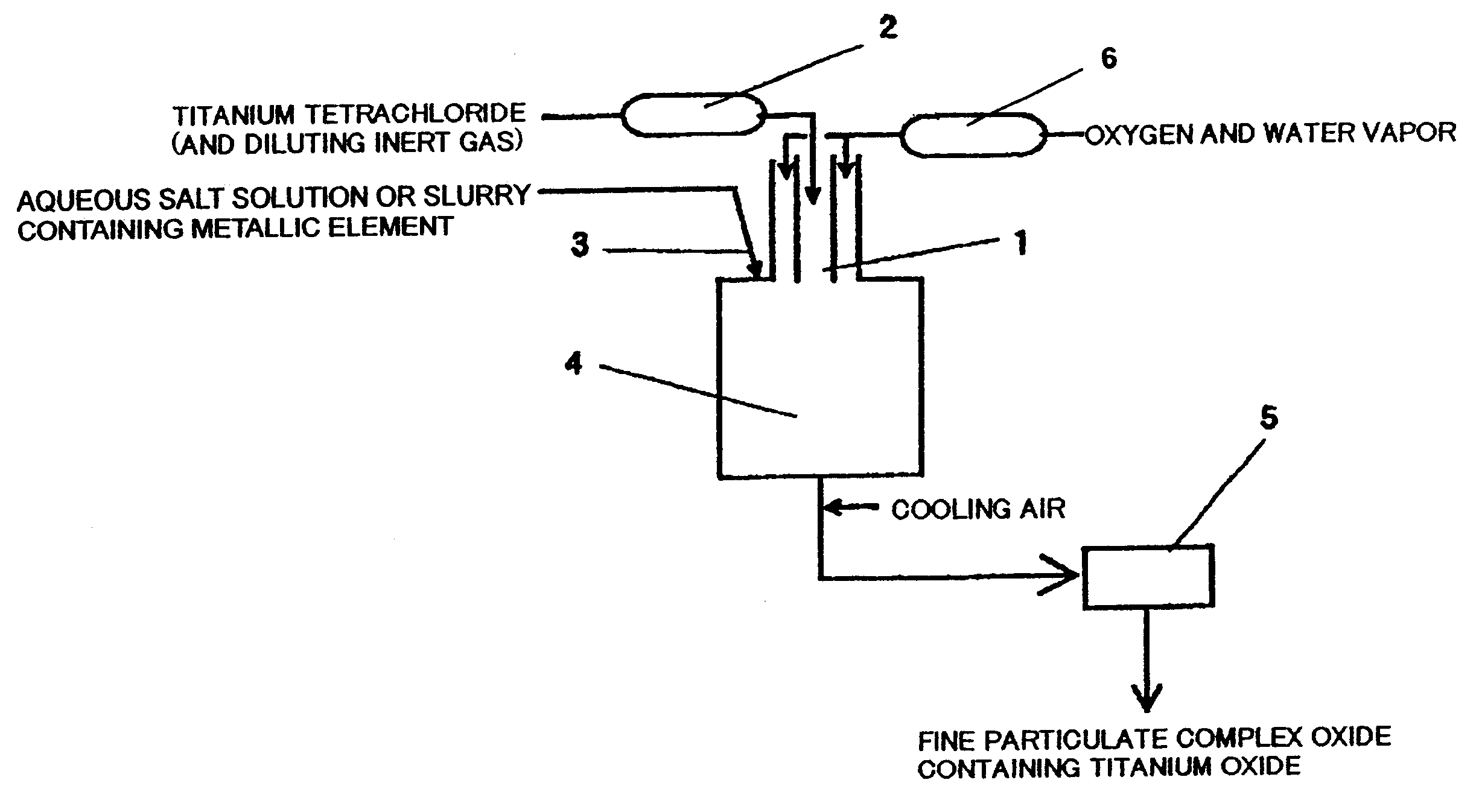Production process for ultrafine particulate complex oxide containing titanium oxide
a technology of complex oxide and titanium oxide, which is applied in the direction of cellulosic plastic layered products, natural mineral layered products, transportation and packaging, etc., can solve the problems of increasing residual chlorine after dechlorination and difficult formation of ultrafine particles, so as to suppress the growth of oxide, reduce the growth time, and enhance the chemical reactivity.
- Summary
- Abstract
- Description
- Claims
- Application Information
AI Technical Summary
Benefits of technology
Problems solved by technology
Method used
Image
Examples
example 1
11.8 Nm.sup.3 / hr (N means Standard State, hereinafter the same) of gaseous titanium tetrachloride in a concentration of 100 vol % and a mixed gas containing 8 Nm.sup.3 / hr of oxygen and 20 Nm.sup.3 / hr of water vapor were preheated to 1,100.degree. C. and 1,000.degree. C., respectively, and then introduced into a reaction tube using a coaxial parallel-flow nozzle at a flow rate of 53 m / sec and 50 m / sec, respectively. At this time, 3.7 kg / hr of an aqueous 20% zirconium oxychloride solution was sprayed from the outer circumferential part of the coaxial parallel-flow nozzle. In the reaction, a reaction tube as shown in FIG. 1 was used. The inner tube of the coaxial parallel-flow nozzle had a diameter of 20 mm and the starting material gas containing titanium tetrachloride was introduced into the inner tube.
The inside flow rate at a reaction temperature of 900.degree. C. within the reaction tube was 10 m / sec, as calculated. For controlling the high-temperature residence time within the...
example 2
A starting material gas containing titanium tetrachloride obtained by mixing 10.6 Nm.sup.3 / hr of gaseous titanium tetrachloride and 6.0 Nm.sup.3 / hr of nitrogen and a mixed gas containing 8 Nm.sup.3 / hr of oxygen and 30 Nm.sup.3 / hr of water vapor were preheated to 1,100.degree. C. and 1,100.degree. C., respectively, and then introduced into a reaction tube using a coaxial parallel-flow nozzle at a flow rate of 74 m / sec and 66 m / sec, respectively. At this time, 7.1 kg / hr of an aqueous 20% chromium trichloride solution was sprayed from the outer circumferential part of the coaxial parallel-flow nozzle. In the reaction, a reaction tube as shown in FIG. 1 was used. The inner tube of the coaxial parallel-flow nozzle had a diameter of 20 mm and the starting material gas containing titanium tetrachloride was introduced into the inner tube.
The inside flow rate at a reaction temperature of 1,000.degree. C. within the reaction tube was 10 m / sec, as calculated. For controlling the high-tempe...
example 3
A starting material gas containing titanium tetrachloride obtained by mixing 10.6 Nm.sup.3 / hr of gaseous titanium tetrachloride and 10.0 Nm.sup.3 / hr of nitrogen and a mixed gas containing 8 Nm.sup.3 / hr of oxygen and 30 Nm.sup.3 / hr of water vapor were preheated to 1,050.degree. C. and 1,100.degree. C., respectively, and then introduced into a reaction tube using a coaxial parallel-flow nozzle at a flow rate of 64 m / sec and 36 m / sec, respectively. At this time, 6.5 kg / hr of an aqueous 20% magnesium nitrate solution was sprayed from the outer circumferential part of the coaxial parallel-flow nozzle. In the reaction, a reaction tube as shown in FIG. 1 was used. The inner tube of the coaxial parallel-flow nozzle had a diameter of 24 mm and the starting material gas containing titanium tetrachloride was introduced into the inner tube.
The inside flow rate at a reaction temperature of 1,000.degree. C. within the reaction tube was 10 m / sec, as calculated. For controlling the high-tempera...
PUM
| Property | Measurement | Unit |
|---|---|---|
| boiling point | aaaaa | aaaaa |
| temperature | aaaaa | aaaaa |
| diameter | aaaaa | aaaaa |
Abstract
Description
Claims
Application Information
 Login to View More
Login to View More - R&D
- Intellectual Property
- Life Sciences
- Materials
- Tech Scout
- Unparalleled Data Quality
- Higher Quality Content
- 60% Fewer Hallucinations
Browse by: Latest US Patents, China's latest patents, Technical Efficacy Thesaurus, Application Domain, Technology Topic, Popular Technical Reports.
© 2025 PatSnap. All rights reserved.Legal|Privacy policy|Modern Slavery Act Transparency Statement|Sitemap|About US| Contact US: help@patsnap.com


